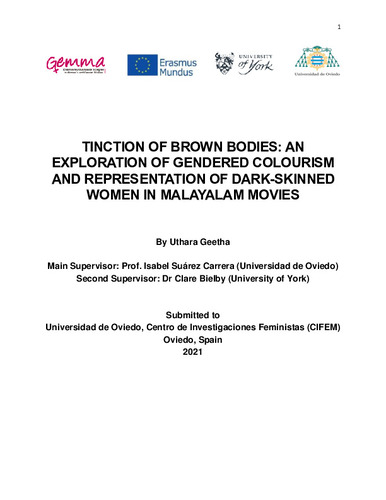Tinction of brown bodies: an exploration of gendered colourism and representation of dark-skinned women in Malayalam movies
Autor(es) y otros:
Director(es):
Fecha de publicación:
Serie:
Máster Universitario Erasmus Mundus en Estudios de las Mujeres y de Género
Descripción física:
Resumen:
Indian society suffers from deep-rooted colourism emerging from its complex history of early racial mixing, rigid social systems and colonialization, which results in the active practice of skincolour based discrimination in socio-cultural spaces. Due to the mixed-race and culturally diverse nature of Indian society, this study sought to decode colourism as a racial hierarchy which is intertwined with other forms of discriminations. In particular, I argue, pre-existing indigenous social inequalities— caste, class and region— were reinterpreted in terms of skin colour following co-option of colonial racist ideologies by native elite to legitimise discrimination against the historically oppressed groups. Colourism is perpetuated through popular stereotypes which establishes dark skin colour as a signifier of lower class, lower caste and South Indian identity rooted in biological difference and essentialism. Furthermore, colourism in modern India is a highly gendered phenomenon. Due to normalisation of white beauty ideals by media and racialised capitalist economies in the present-day globalised Indian society, the awareness of the inadequacy of dark skin in a colourist society moulds their positionality and ways of knowing in a similar process to how race builds unique lived experience. Cinema as an artform and industry has huge influence in India and serves as an appropriate research platform to analyse colourism and its socio-cultural connotations. Taking into consideration marginalisation of dark-skinned women and cinema as a cultural platform, the study focused on the ways of representations of darker skinned women in Malayalam films. Two films were chosen for detailed analysis-—Celluloid (2013) and Kammattipadam (2016)— which have dark-skinned female leads, an exception in commercial and mainstream cinema production in India. The research sought to investigate the reasons behind the choice and how it influences the representation of women and the role of skin-colour in cinema production. The research found close association between popular skin-colour based stereotypes and representation of bodies in the films. The findings reveal that the films reflect and adhere to above-mentioned skin-colour based stereotypes and help to maintain the status quo of socio-cultural and gendered inequalities underutilising the subversive potential of cinema.
Indian society suffers from deep-rooted colourism emerging from its complex history of early racial mixing, rigid social systems and colonialization, which results in the active practice of skincolour based discrimination in socio-cultural spaces. Due to the mixed-race and culturally diverse nature of Indian society, this study sought to decode colourism as a racial hierarchy which is intertwined with other forms of discriminations. In particular, I argue, pre-existing indigenous social inequalities— caste, class and region— were reinterpreted in terms of skin colour following co-option of colonial racist ideologies by native elite to legitimise discrimination against the historically oppressed groups. Colourism is perpetuated through popular stereotypes which establishes dark skin colour as a signifier of lower class, lower caste and South Indian identity rooted in biological difference and essentialism. Furthermore, colourism in modern India is a highly gendered phenomenon. Due to normalisation of white beauty ideals by media and racialised capitalist economies in the present-day globalised Indian society, the awareness of the inadequacy of dark skin in a colourist society moulds their positionality and ways of knowing in a similar process to how race builds unique lived experience. Cinema as an artform and industry has huge influence in India and serves as an appropriate research platform to analyse colourism and its socio-cultural connotations. Taking into consideration marginalisation of dark-skinned women and cinema as a cultural platform, the study focused on the ways of representations of darker skinned women in Malayalam films. Two films were chosen for detailed analysis-—Celluloid (2013) and Kammattipadam (2016)— which have dark-skinned female leads, an exception in commercial and mainstream cinema production in India. The research sought to investigate the reasons behind the choice and how it influences the representation of women and the role of skin-colour in cinema production. The research found close association between popular skin-colour based stereotypes and representation of bodies in the films. The findings reveal that the films reflect and adhere to above-mentioned skin-colour based stereotypes and help to maintain the status quo of socio-cultural and gendered inequalities underutilising the subversive potential of cinema.
Colecciones
- Trabajos Fin de Máster [5296]
Ficheros en el ítem





